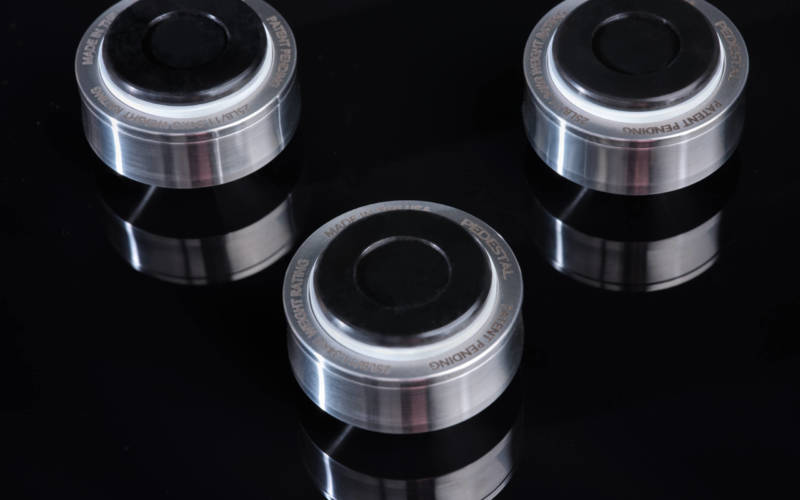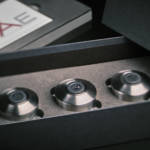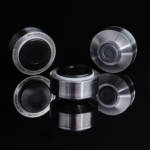Wilson’s experience in and commitment to the science and technology of resonance control is unsurpassed within the audio industry. Before most loudspeaker engineers had even considered the harmful effects of deficient cabinet materials on a transducer’s ability to accurately pass an incoming signal, Dave Wilson was actively exploring esoteric composite cabinet strategies.
That was over 40 years ago. In the intervening four decades, Wilson Audio has continued its inexhaustible search for the best non-resonant composites for specific applications. In their ongoing pursuit of greater fidelity, Wilson has also delved into the art and science of combining specific composites in strategic geometries. No other audio company has invested a greater percentage of its capital resources into the research and development of materials and composites than Wilson Audio. Its design team, armed with state-of-the-art testing tools, has explored, discovered, and developed more groundbreaking composites than any other audio company.
Wilson’s latest and most advanced materials, “W” and “V”, made their debut into the limited production WAMM Master Chronosonic® (W-Material) and, most recently, Wilson’s flagship loudspeaker, the Chronosonic XVX™ (V-Material). At the other end of the spectrum, Wilson’s Special Application Engineering Division engineered the groundbreaking ISOBase™, a unique isolation platform for the TuneTot™. The ISOBase allowed the TuneTot to be placed on bookshelves and desktops with heretofore unachievable isolation from those resonant surfaces.
The design and engineering team’s research surrounding the ISOBase led to a realization: the fundamental tenets that made the ISOBase so capable could form the basis for a state-of-the-art isolation device for general use. Thus, a multi-year-long research and development project commenced. The outgrowth of which was the Pedestal—Wilson Audio Special Application Engineering’s solution for near absolute vibration isolation.
Introducing the WASAE Pedestal™
A Uniquely “Wilson” Approach to Vibration Mitigation
As any physicist knows, no device, no matter how clever or sophisticated, can eliminate energy. It can only convert undesirable energy into a more benign force. This applies to unwanted vibrations that hamper the fidelity of both transducers (such as analog playback devices) and electronics (which are susceptible to vibration-induced microphonics).
With this understanding, Wilson Audio’s Special Application Engineering team has always approached the problem of vibration mitigation from a scientific perspective. When designing its new isolation device, the WASAE team leveraged Wilson’s industry-leading measurement capabilities, which have evolved continuously from their perennial quest for the best solutions for ultra-low resonance speaker enclosures.
The Pedestal reduces musically destructive vibrations systematically. Its small bottom element partially absorbs vibrations traveling from the surface underneath the piece of equipment. Next, energy migrates into the Pedestal’s austenitic (non-magnetic) stainless-steel housing, where the material’s mass and solidity further turn unwanted energy into heat. Where other manufacturers use low-grade magnetic steel in their isolation pods, Wilson is committed to metals that have superior vibration-mitigating characteristics as well as the ability to minimize electronic interactions of the components which the Pedestals support.
The damping material inside of the Pedestal—“V-Material”—provides the next step in vibration reduction. V-Material, along with a proprietary viscous damping material inside the Pedestal, act as a spring to minimize, absorb, and dissipate the vibrations into heat.
When weight is applied to the Pedestal, the internal V-Material element, along with the other critical elements within the housing, are decoupled from the stainless steel exterior.
From the reverse direction, from the component on down, any vibrations caused by environmental factors or from the audio system itself, travel into the top pad of the Pedestal, where they are reduced. From there, any remaining vibrations are guided directly to the V-Material where they are effectively absorbed and dissipated as heat.
Low-frequency, high-amplitude vibrations, such as those generated by footfalls, are reduced via the spring-like action of the V-Material and damping material combination.
Important Details
- Each Pedestal is rated for weights up to 25lb/11.34Kg. A set of three successfully supports 75lbs. Add more Pedestals to accommodate greater weights.
- The white color ring indicates when max weight rating has been reached—when the ring disappears, the Pedestal has reached its maximum load.
- Shipped in quantities of up to 3 units per box.
- Designed for use under electronics, digital transports, power supplies, tape machines, and turntables to acoustically isolate these components from the environment as well as to substantially reduce vibrations traveling from components to the surface below.
NOT intended for use under loudspeakers.
WASAE’s patent pending design provides an unprecedented degree of decoupling between outer housing and constrained damping layers.
Designed and manufactured alongside Wilson Audio loudspeakers in the USA.
Science and Music
Established by Dave Wilson over four decades ago, Wilson’s research and development processes have always been based on the combination of scientific research, controlled and repeatable measurements, and systematic verification via empirical listening. Wilson continues to invest heavily in the acquisition of state-of-the-art equipment and tools to serve this end.
Now, under the leadership of Dave’s son Daryl Wilson, Wilson’s design and engineering team have continued to refine and perfect the scientific research model. Critical to any engineering effort is asking the right questions. But it doesn’t end there. Extreme vigilance is necessary to ensure that the question asked by the engineers is answered honestly and accurately. Critical to the design processes and experiments is the elimination of other distracting variables that would potentially yield confusing or, worse yet, tainted information.
The Results
One of the questions the engineers asked while developing the Pedestal: How well does the isolation device under test reduce unwanted broadband energy from entering an audio component. In order to measure their progress accurately, the design team employed an innovative tool, Wilson’s Modal Exciter, which introduces broadband vibrations into a structure in a precisely controlled and repeatable way.
The engineers placed the isolation product under test on Wilson’s Modal Exciter, positioned in such a way that duplicated real-world applications. The team then placed a substrate, with the dimensions and weight of a typical audio component, on top of the set of the isolation products under test. Using Wilson’s 3-Dimensional Accelerometer, another of the team’s sophisticated research tools, the engineers measured the remaining energy in the substrate.
Wilson’s engineers utilized this experimental procedure to chart the engineers’ progress during the development of the Pedestal. Using the same method, they conducted further comparisons between the Pedestal and several competing devices.
The charts to the left and right illustrate a sampling of the results of our testing. The red line represents the original energy. The line beneath is the energy that remains in the component placed upon the set of devices. The devices were sample isolation products from prevalent manufactures in this product segment and ranged in price from $500 to $2,700 a set.
Price (U.S. MSRP)
Pedestal Full Set (three)—$2,225
Additional Singles—$775
Approximate Availability:
Mid-May 2020








